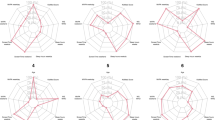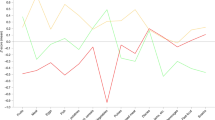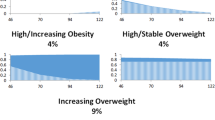Abstract
Background/Objectives:
Evidence suggests diet, physical activity (PA) and sedentary behaviour cluster together in children, but research supporting an association with overweight/obesity is equivocal. Furthermore, the stability of clusters over time is unknown. The aim of this study was to examine the clustering of diet, PA and sedentary behaviour in Australian children and cross-sectional and longitudinal associations with overweight/obesity. Stability of obesity-related clusters over 3 years was also examined.
Subjects/Methods:
Data were drawn from the baseline (T1: 2002/2003) and follow-up waves (T2: 2005/2006) of the Health Eating and Play Study. Parents of Australian children aged 5–6 (n=87) and 10–12 years (n=123) completed questionnaires. Children wore accelerometers and height and weight were measured. Obesity-related clusters were determined using K-medians cluster analysis. Multivariate regression models assessed cross-sectional and longitudinal associations between cluster membership, and body mass index (BMI) Z-score and weight status. Kappa statistics assessed cluster stability over time.
Results:
Three clusters, labelled ‘most healthy’, ‘energy-dense (ED) consumers who watch TV’ and ‘high sedentary behaviour/low moderate-to-vigorous PA’ were identified at baseline and at follow-up. No cross-sectional associations were found between cluster membership, and BMI Z-score or weight status at baseline. Longitudinally, children in the ‘ED consumers who watch TV’ cluster had a higher odds of being overweight/obese at follow-up (odds ratio=2.8; 95% confidence interval: 1.1, 6.9; P<0.05). Tracking of cluster membership was fair to moderate in younger (K=0.24; P=0.0001) and older children (K=0.46; P<0.0001).
Conclusions:
This study identified an unhealthy cluster of TV viewing with ED food/drink consumption, which predicted overweight/obesity in a small longitudinal sample of Australian children. Cluster stability was fair to moderate over 3 years and is a novel finding. Prospective research in larger samples is needed to examine how obesity-related clusters track over time and influence the development of overweight and obesity.
This is a preview of subscription content, access via your institution
Access options
Subscribe to this journal
Receive 12 print issues and online access
$259.00 per year
only $21.58 per issue
Buy this article
- Purchase on Springer Link
- Instant access to full article PDF
Prices may be subject to local taxes which are calculated during checkout
Similar content being viewed by others

References
Australian Bureau of Statistics Australian Health Survey: First Results, 2011-12. Cat. no. 4364.0.55001. ABS: Canberra, 2012.
World Health Organization (WHO) Global Health Risks: Mortality and Burden of Disease Attributable to Selected Major Risk Factors. World Health Organization: Geneva, 2009.
Lobstein T, Bauer L, Uauy R, The IASO International Obesity TaskForce. Obesity in children and young people: a crisis in public health. Obes Rev 2004; 5 (Suppl 1): 4–85.
Carlson JA, Crespo NC, Sallis JF, Patterson RE, Elder JP . Dietary-related and physical activity-related predictors of obesity in children: a 2-year prospective study. Child Obes 2012; 8: 110–115.
Swinburn BA, Caterson I, Seidell JC, James WPT . Diet, nutrition and the prevention of excess weight gain and obesity. Public Health Nutr 2004; 7: 123–146.
Landsberg B, Plachta-Danielzik S, Lange D, Johannsen M, Seiberl J, Müller MJ . Clustering of lifestyle factors and association with overweight in adolescents of the Kiel Obesity Prevention Study. Public Health Nutr 2010; 13: 1708–1715.
Ottevaere C, Huybrechts I, Benser J, De Bourdeaudhuij I, Cuenca-Garcia M, Dallongeville J et al. Clustering patterns of physical activity, sedentary and dietary behavior among European adolescents: the HELENA study. BMC Public Health 2011; 11: 328.
Cameron AJ, Crawford DA, Salmon J, Campbell K, McNaughton SA, Mishra GD et al. Clustering of obesity-related risk behaviors in children and their mothers. Ann Epidemiol 2011; 21: 95–102.
Hardy LL, Grunseit A, Khambalia A, Bell C, Wolfenden L, Milat AJ . Co-occurrence of obesogenic risk factors among adolescents. J Adolesc Health 2012; 51: 265–271.
Sanchez A, Norman GJ, Sallis JF, Calfas KJ, Cella J, Patrick K . Patterns and correlates of physical activity and nutrition behaviors in adolescents. Am J Prev Med 2007; 32: 124–130.
Huh J, Riggs NR, Spruijt-Metz D, Chou C-P, Huang Z, Pentz M . Identifying patterns of eating and physical activity in children: a latent class analysis of obesity risk. Obesity (Silver Spring, MD) 2011; 19: 652–658.
Seghers J, Rutten C . Clustering of multiple lifestyle behaviours and its relationship with weight status and cardiorespiratory fitness in a sample of Flemish 11- to 12-year-olds. Public Health Nutr 2010; 13: 1838–1846.
Leech RM, McNaughton SA, Timperio A . The clustering of diet, physical activity and sedentary behavior in children and adolescents: a review. Int J Behav Nutr Phys Act 2014; 11: 4.
Boone-Heinonen J, Gordon-Larsen P, Adair LS . Obesogenic clusters: multidimensional adolescent obesity-related behaviors in the U.S. Ann Behav Med 2008; 36: 217–230.
Magee CA, Caputi P, Iverson DC . Patterns of health behaviours predict obesity in Australian children. J Paediatr Child Health 2013; 49: 291–296.
Gubbels JS, Kremers SP, Goldbohm RA, Stafleu A, Thijs C . Energy balance-related behavioural patterns in 5-year-old children and the longitudinal association with weight status development in early childhood. Public Health Nutr 2012; 15: 1402–1410.
Marshall SJ, Biddle SJH, Sallis JF, McKenzie TL, Conway TL . Clustering of sedentary behaviors and physical activity among youth: a cross-national study. Pediatr Exerc Sci 2002; 14: 401–417.
Patnode CD, Lytle LA, Erickson DJ, Sirard JR, Barr-Anderson DJ, Story M . Physical activity and sedentary activity patterns among children and adolescents: a latent class analysis approach. J Phys Act Health 2011; 8: 457–467.
Sabbe D, De Bourdeaudhuij I, Legiest E, Maes L . A cluster-analytical approach towards physical activity and eating habits among 10-year-old children. Health Educ Res 2008; 23: 753–762.
te Velde SJ, De Bourdeaudhuij I, Thorsdottir I, Rasmussen M, Hagstromer M, Klepp KI et al. Patterns in sedentary and exercise behaviors and associations with overweight in 9-14-year-old boys and girls—a cross-sectional study. BMC Public Health 2007; 7: 16.
Turner K, Dwyer JJM, Edwards AM, Allison KR . Clustering of specific health-related behaviours among Toronto adolescents. Can J Diet Pract Res 2011; 72: e155–e160.
Salmon J, Campbell KJ, Crawford DA . Television viewing habits associated with obesity risk factors: a survey of Melbourne schoolchildren. Med J Aust 2006; 184: 64–67.
Leech RM, McNaughton SA, Crawford DA, Campbell KJ, Pearson N, Timperio A . Family food involvement and frequency of family dinner meals among Australian children aged 10-12years. Cross-sectional and longitudinal associations with dietary patterns. Appetite 2014; 75: 64–70.
Australian Bureau of Statistics Socio-Economic Indexes for Areas, 1996. ABS: Canberra, 1998. Report no.: Catalogue No. 2033.0.30.001.
Kuczmarski RJ, Ogden CL, Grummer-Strawn LM, Flegal KM, Guo SS, Wei R et al. CDC growth charts: United States. Adv Data 2000; (314): 1–27.
Cole TJ, Bellizzi MC, Flegal KM, Dietz WH . Establishing a standard definition for child overweight and obesity worldwide: international survey. BMJ 2000; 320: 1240–1243.
Leech RM, McNaughton SA, Timperio A . Clustering of children's obesity-related behaviours: associations with sociodemographic indicators. Eur J Clin Nutr 2014; 68: 623–628.
Willett W . Nutritional Epidemiology 2nd edn (Oxford University Press: New York, 1998.
Catellier DJ, Hannan PJ, Murray DM, Addy CL, Conway TL, Yang S et al. Imputation of missing data when measuring physical activity by accelerometry. Med Sci Sports Exerc 2005; 37 (11 Suppl): S555–S562.
Ward DS, Evenson KR, Vaughn A, Rodgers AB, Troiano RP . Accelerometer use in physical activity: best practices and research recommendations. Med Sci Sports Exerc 2005; 37 (11 Suppl): S582–S588.
Freedson P, Pober D, Janz KF . Calibration of accelerometer output for children. Med Sci Sports Exerc 2005; 37 (11 Suppl): S523–S530.
Trost SG, McIver KL, Pate RR . Conducting accelerometer-based activity assessments in field-based research. Med Sci Sports Exerc 2005; 37 (11 Suppl): S531–S543.
Trost SG, Loprinzi PD, Moore R, Pfeiffer KA . Comparison of accelerometer cut points for predicting activity intensity in youth. Med Sci Sports Exerc 2011; 43: 1360–1368.
Everitt BS, Landau S, Leese M, Stahl D . Cluster Analysis 5th edn (John Wiley & Sons, Ltd: West Sussex, 2011.
Landis JR, Koch GG . The analysis of categorical data in longitudinal studies of behavioral development. In: Nesselroade JR, Baltes PB (eds). Longitudinal Methodology in the Study of Behavior and Development. Academic Press: New York, 1979, pp 233–261.
van der Sluis ME, Lien N, Twisk JWR, Steenhuis IHM, Bere E, Klepp K-I et al. Longitudinal associations of energy balance-related behaviours and cross-sectional associations of clusters and body mass index in Norwegian adolescents. Public Health Nutr 2010; 13: 1716–1721.
Telama R . Tracking of physical activity from childhood to adulthood: a review. Obes Facts 2009; 2: 187–195.
Basterfield L, Adamson AJ, Frary JK, Parkinson KN, Pearce MS, Reilly JJ et al. Longitudinal study of physical activity and sedentary behavior in children. Pediatrics 2011; 127: e24–e30.
Kwon S, Janz KF . Tracking of accelerometry-measured physical activity during childhood: ICAD pooled analysis. Int J Behav Nutr Phys Act 2012; 9: 68.
Oellingrath IM, Svendsen MV, Brantsaeter AL . Tracking of eating patterns and overweight—a follow-up study of Norwegian schoolchildren from middle childhood to early adolescence. Nutr J 2011; 10: 106.
Lake AA, Mathers JC, Rugg-Gunn AJ, Adamson AJ . Longitudinal changes in food habits between adolescence (11-12 years) and adulthood (32-33 years): the ASH30 study. J Public Health (Oxf) 2006; 28: 10–16.
Madruga SW, Araujo CL, Bertoldi AD, Neutzling MB . Tracking of dietary patterns from childhood to adolescence. Rev Saude Publica 2012; 46: 376–386.
Craigie AM, Lake AA, Kelly SA, Adamson AJ, Mathers JC . Tracking of obesity-related behaviours from childhood to adulthood: A systematic review. Maturitas 2011; 70: 266–284.
Nelson MC, Neumark-Stzainer D, Hannan PJ, Sirard JR, Story M . Longitudinal and secular trends in physical activity and sedentary behavior during adolescence. Pediatrics 2006; 118: e1627–e1634.
Byers T . Food frequency dietary assessment: how bad is good enough? Am J Epidemiol 2001; 154: 1087–1088.
Magarey A, Watson J, Golley RK, Burrows T, Sutherland R, McNaughton SA et al. Assessing dietary intake in children and adolescents: Considerations and recommendations for obesity research. Int J Pediatr Obes 2011; 6: 2–11.
Wang Y . Is obesity associated with early sexual maturation? A comparison of the association in American boys versus girls. Pediatrics 2002; 110: 903–910.
Prochaska JJ, Spring B, Nigg CR . Multiple health behavior change research: an introduction and overview. Prev Med 2008; 46: 181–188.
Pearson N, Ball K, Crawford D . Mediators of longitudinal associations between television viewing and eating behaviours in adolescents. Int J Behav Nutr Phys Act 2011; 8: 23.
Harris JL, Bargh JA, Brownell KD . Priming effects of television food advertising on eating behavior. Health Psychol 2009; 28: 404–413.
Acknowledgements
The HEAPS was funded by the Victorian Health Promotion Foundation (baseline) and the Australian Research Council (follow-up, ID: DP0664206). SAM is supported by an Australian Research Council (ARC) Future Fellowship (FT100100581). AT is supported by a National Heart Foundation of Australia Future Leader fellowship (ID: 100046). The funding bodies had no role in the analysis or preparation of the manuscript.
Author information
Authors and Affiliations
Corresponding author
Ethics declarations
Competing interests
The authors declare no conflict of interest.
Rights and permissions
About this article
Cite this article
Leech, R., McNaughton, S. & Timperio, A. Clustering of diet, physical activity and sedentary behaviour among Australian children: cross-sectional and longitudinal associations with overweight and obesity. Int J Obes 39, 1079–1085 (2015). https://doi.org/10.1038/ijo.2015.66
Received:
Revised:
Accepted:
Published:
Issue Date:
DOI: https://doi.org/10.1038/ijo.2015.66
This article is cited by
-
Clustering of diet, physical activity and sedentary behaviour and related physical and mental health outcomes: a systematic review
BMC Public Health (2023)
-
Clustering of lifestyle and health behaviours in Australian adolescents and associations with obesity, self-rated health and quality of life
BMC Public Health (2023)
-
Clustering of lifestyle behaviors and adiposity in early adolescents in Spain: findings from the SI! Program for Secondary Schools
BMC Public Health (2023)
-
Clustering of Physical Activity, Sleep, Diet, and Screen-Based Device Use Associated with Self-Rated Health in Adolescents
International Journal of Behavioral Medicine (2022)
-
How physical activity, diet, and sedentary behavior cluster according to age in adolescents?
Sport Sciences for Health (2022)


